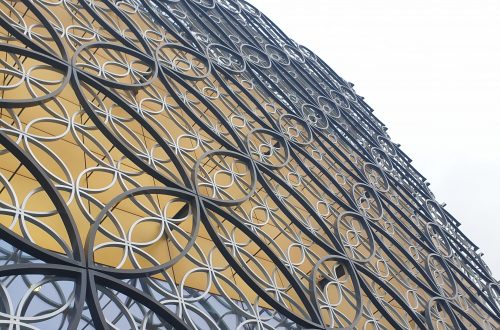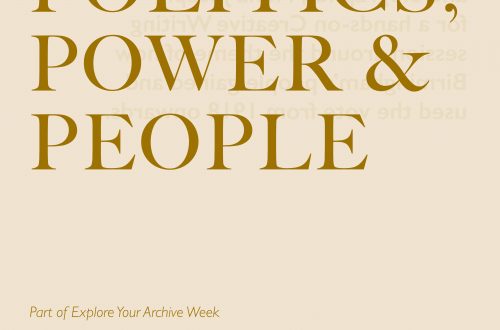
Post WW1 Housing around Edgbaston Community Centre
Liz Palmer writes about her research into historic housing developments in Edgbaston and her work with members of Edgbaston Community Centre.
As part of the Represent project we have been working with a group of local residents who meet regularly at the Edgbaston Community Centre on Woodview Drive. We had already identified that the three candidates for Ladywood in the 1918 General Election had focused on housing conditions and so this seemed the ideal topic to focus on with the group, many of whom have lived in the Lee Bank area for most of their lives. They were mainly born in the 1930s and 40s so their memories stretch back to WW2 and they have received memories from their parents who would have been growing up through WW1 and the 1920s.
From the start we wanted to include a walk in the area even though we strongly suspected that there would be few remnants of the period housing in the area, because it has gone through extensive redevelopment in both the 1960s and again in the early 2000s. It was apparent on our first meeting with the group that any walk would need to be fairly short as several members had limited mobility. Therefore, we would need to concentrate on the few streets immediately surrounding the Community Centre and would not be able to cross the Ladywood Middleway into the heart of what is now known as Attwood Green but for decades had been Lee Bank.
We used the side-by-side feature on the National Library of Scotland maps website to compare the street lay-out on the Ordnance Survey map of 1913 with a current map (not shown for copyright reasons) and plotted out a suitable route with an optional short cut.

We discovered that despite the two major redevelopments that the basic road layout was still mainly intact although there had been some changes in a few road names. The Community Centre is on Woodview Road but this was previously known as Gough Road (the name has been retained on the western side of the junction with Charlotte Road). But Summer Road, Spring Road, Wellington Road and Charlotte Road all retain their names as does Cambridge Crescent although this is now shorter and there are a couple of newer roads including Brambling Road and Springbank Road.
Looking at the map we could see that the most of the original houses in the area were fairly standard terraced houses with gardens but with sections between Summer Road and Ryland Road and just to the south of Sun Street with more densely packed back-to-back or court houses which were more akin to the houses on the north of Sun Street West and Sun Street (now Lee Bank Middleway).
Establishing the route and the old road names helped with the next task which was to search for photographs and other evidence of what the houses in the area were like. The archives catalogue at Library of Birmingham was searched for photographs and we also made use of the images at on the Birmingham Images site which include many from the Library of Birmingham but also some from other sources.
Several of the images with accompanying text were copied to History Pin and edited into a short virtual tour. This together with a powerpoint presentation would enable those unable to take the walk to still explore the area and get more of a sense of the geography and history of the area than simply a series of random photographs.
Most of the photographs found were taken much later than the time period we were focusing on, ie 1918-1928, but they showed residential buildings, shops and public houses that were basically unchanged for several decades. In some cases other documentary evidence had been found to show the continuity of use. For example one of the photographs shows an off-licence at 35 Summer Road taken in 1960. Both the 1911 census and the 1939 National Register as well as Trade directory entries show that there was continual use of these premises as a beer retailer.

On the day scheduled for the walk the weather was unseasonably cool and members of the group were reluctant to leave the warmth of the centre, so we did fall back on Plan B and did a virtual tour with the use of maps and photographs. Several of the groups had lived in the area or nearby and others had lived in a similar style of housing and so were able to contribute many memories and experiences of their own. For instance, with the photograph of the off-licence we could see the residential properties to the left which brought back memories for one member of the group about her childhood home with its 3 storey layout with the parlour & kitchen on ground floor, bedroom on the 1st floor and the attic bedroom shared by the children of the family. Another lady commented on the alleyway to the right of the off-licence which would have been the entry into one of the courts at the back.
After talking about the housing in the area, we spent some time considering specific problems of back-to-back houses and in particular the link with ill-health and mortality statistics. This was well documented in the 1918 Birmingham Medical Officer of Health Report and this graphic (below) was particularly striking. It gave a visual representation which was very easy to understand. The annual MoH reports for Birmingham can be viewed at the Library of Birmingham but can also be viewed online at https://wellcomelibrary.org/moh/about-the-reports/about-the-medical-officer-of-health-reports/

We finished the session by looking at the Council’s response to the post WW1 housing crisis, which was to invest in municipal housing primarily in new purpose built estates on previously rural land in the outer suburbs of the City. Most of the group were surprised to learn that until 1911 Birmingham was relatively small and compact and that most of todays suburbs had been entirely separate.
One of the primary reasons for Birmingham taking in these other areas including Balsall Heath, Moseley, Kings Heath, Kings Norton, Northfield, Handsworth, Erdington and Sheldon had been to provide space for Birmingham’s growing population and to provide a healthier alternative to the congested inner city areas. Plans were put on hold because of the First World War, and also there were political tensions over whether or not the private sector would provide the required number of houses or whether they needed to be funded by the local authority.
Eventually finances were made available via the council and by 1926, with 13,000 council homes completed, Birmingham had become the largest municipal housing provider in the country outside London. And by 1933 it had built over 33,000 houses. The 1931 map of City of Birmingham Housing Estates shows clearly how these new estates were situated in the outer ring of the city. But it would be another 20-30 years before the majority of the inner city back-to-backs would be finally knocked down. Which is why many of the group were born into such housing and had vivid memories of the communities they grew up in. They had also lived through the 1960s redevelopments and several had lived in tower blocks – and at least one still did. But many of these had subsequently been knocked down and replaced with normal housing stock.

The group were amused by the prescient 1918 comments of the Medical Officer of Health for Birmingham, John Robertson, who after stating that the only remedy to the housing crisis was “the replacement of slums by decent houses in a pleasant environment” went on to say:
“I would like to make one further observation in this respect. It is that I very strongly advise that block buildings (flats) should not under any conditions be contemplated as a substitute for the back-to-back courtyard houses, as I believe that such in time will become even more unwholesome than the courtyard cottage”.
John Robertson, Medical Officer of Health for Birmingham in 1918




